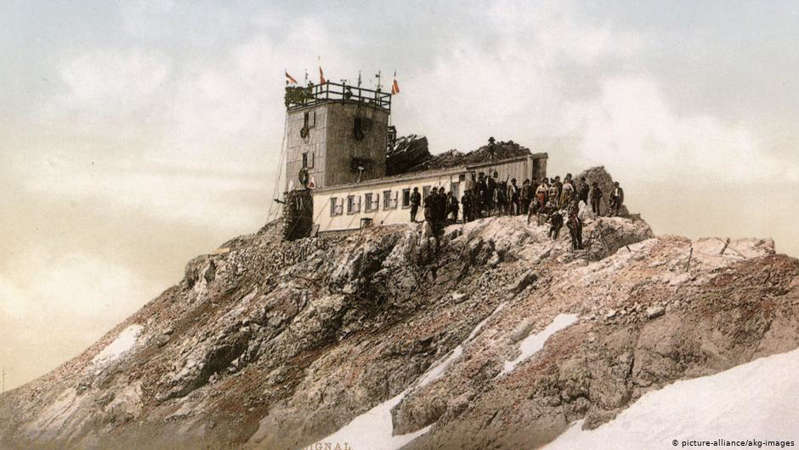
Hurricane
Every year, German meteorologists have to name 130-150 cyclones and 50-60 anticyclones that affect the weather in Germany, or rather, in Central Europe. For a long time, they used standard repeating lists – ten for cyclones and ten for anticyclones. Each of the lists contained 26 female or male names – one for each basic letter of the Latin alphabet. Until 1998, cyclones were given female names, anticyclones – male names, but then an annual rotation was introduced.
The next innovation on the weather front followed in 2002. Due to financial difficulties, one of the oldest weather observation points in Germany, the Educational Weather Station of the Free University of Berlin, was threatened with closure. The local faculty, which trains weather forecasters, is considered one of the main forges of meteorological personnel in Germany. To save the training station, the professional forecaster community, that is, the public service Deutscher Wetterdienst (DWD) and private companies, supported the idea of selling the names of cyclones and anticyclones on weather maps, agreeing to use these names in their reports.
At midnight Tuesday through Wednesday, September 7-8, German meteorologists will just start selling the names of cyclones and anticyclones for next year. To buy a name, or rather to become a “godfather” or “godfather” of the German weather (Wetterpate), in 2022 it will be possible for 240 euros for a cyclone and for 360 euros for an anticyclone. To do this, you need to fill out an application on the website of the Berlin training station, accept the terms of the agreement and transfer the charitable contribution. It turns out several tens of thousands of euros a year, made literally out of thin air, but for good purposes. Next year cyclones in Germany will be named for women, anticyclones for men.
In 2022, the action will be twenty years old. During this time, several thousand people have already become “gods of the weather” – residents of Germany, other European countries, as well as Brazil, Japan, the USA and South Africa. The German names for cyclones and anticyclones are also used in neighboring European states.
Naming requirements for cyclones and anticyclones in Germany
– Only names that meet the requirements of the registry offices are included in the waiting lists. On this issue, let us allow ourselves a small lyrical digression. German registry offices, for example, refuse to register newborns under the names Junge (“Boy”), Stöhrenfried (“Trouble Shooter”), Yoghurt, Cologne and Borussia, but accept names such as Tarzan, Schneevitchen (“Snow White”), Prestige and Chanel. – The names of companies or surnames are not allowed as names of cyclones and anticyclones. Exceptions are possible if they sound like names – for example, Friedrich, Martin, Mercedes. – Double names like Marie-Antoinette, Jean-Jacques or Frank-Walter are also excluded. – In the spelling of names, only the basic letters of the Latin alphabet and German umlauts (ä, ö, ü) can be used. – Names must be unambiguously masculine or feminine. For example, you can't “Alex”, but you can “Alexander” or “Alexandra”.
The lists are arranged alphabetically, with one name for each letter. Therefore, you cannot choose a specific date for yourself.

One of the first German weather stations was opened in 1883 on the Zugspitze mountain in Bavaria
History of the issue
In the first half of the last century, meteorologists assigned names only to devastating disasters and without any system – for example, by the names of sunken ships or places where these disasters occurred. The tradition of doing this systematically originated during World War II in the Pacific. In American meteorological reports, they began to assign female names to tropical cyclones, which made it possible to organize this information and distinguish typhoons in the reports that were observed at the same time. Hurricanes over the Atlantic soon followed, and even later – all cyclones and anticyclones, regardless of their strength.
German meteorologists adopted this experience in 1954, but for many decades the names remained unknown to the general public, or rather, did not attract much attention. The situation changed in 1990, when several strong hurricanes happened in Germany at once – “Daria”, “Vivian” and “Wiebke”. Gusts of wind “Vivian” reached 224 kilometers per hour! It was then that names from working weather reports began to be widely used in press reports and weather forecasts.
Sometimes tropical hurricanes reach Europe from the shores of America. In such cases, they are indicated on German maps by names given by fellow forecasters in Miami – as long as official storm warnings are in effect in the United States. They are given German names after they have been canceled.

It used to be thought that tree frogs can predict the weather, so in Germany weather forecasters are still called
Who monitors the weather in Germany
The German Meteorological Service (DWD) is a government agency with the status of a federal agency. The headquarters are located in Offenbach am Main. It was founded in 1952. The annual budget is about 340 million euros, including contributions to international organizations. The number of full-time employees is about 2300 people.
On the territory of Germany, the DWD weather observation system includes more than fifty basic weather stations, where forecasters work around the clock, as well as more than 130 automatic points. The automatic stations are also located in special containers on more than 430 merchant ships around the world. For its forecasts and statistics, DWD also receives input from nearly 1,800 amateur meteorologists who collaborate with the service on a voluntary and pro bono basis.
Every year the service prepares about 90 thousand general weather forecasts, 500 thousand forecasts for air transport and publishes about 200 thousand warnings about unfavorable weather conditions. It also collects and provides about 7.5 terabytes of weather and climate data annually for public use to all comers – citizens, government departments, scientists and private firms.
See also:
Author: Maxim Nelyubin

